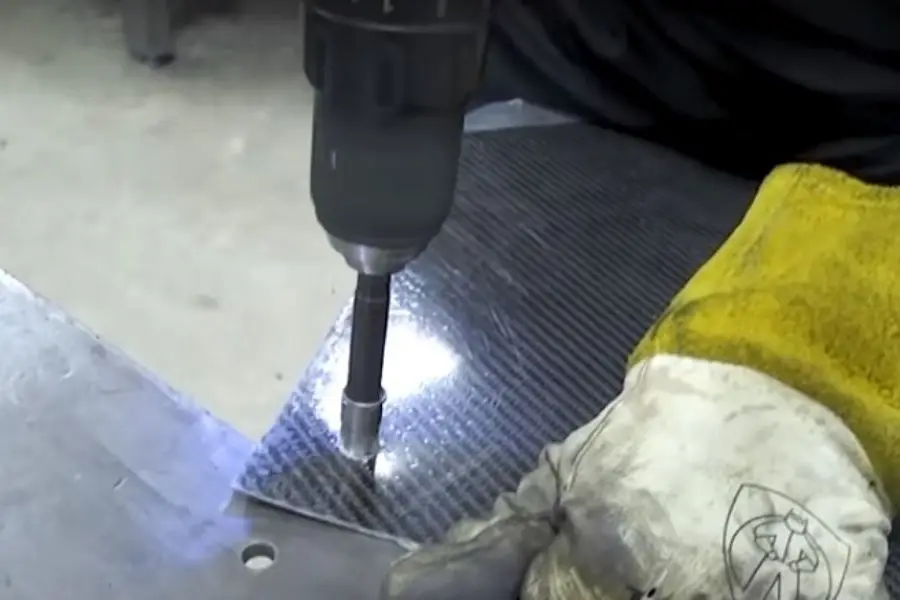Carbon fiber is rightly considered a super material with its high tensile strength and low weight to strength ratio.
Much as this synthetic fiber is popular, drilling into carbon fiber is no piece of cake.
If you need to drill carbon fiber and you want to do this without damaging the material and your tools, look no further.
I have summarized my experience of drilling into carbon fiber in this article to give you all the information you need to get this job right.
So here are a few steps and precautions for drilling into carbon fiber to avoid delamination or splintering.
- Drill carbon fiber using carbide tip or Diamond-tipped drill bits
- High speed metal drill bits will also do the job
- Tape your work priece both ends using blue carpenters tape
- Do not push when you reach the end of the work piece
- Use a sacrificial plexiglass benieth the work piece for better results
- Drill press is recommended over a hand drill for neat holes
You need to carefully select the tools for drilling into carbon fiber, keeping in mind your budget and the amount of drilling you need to do for the project.
I have listed down the tools best suited for each job and the right techniques for using these tools to drill carbon fiber.
Steps to Drill Carbon Fiber:
Carbon fiber is a synthetic material made with thin crystalline carbon filaments.
What makes it the material of choice for engineers and designers is its strength instead of its weight. Despite being much stronger than steel, carbon fiber is much lighter as compared to it.
These and many more reasons compel DIY enthusiasts like me to use carbon fiber in our projects. And even though it has a lot to offer for your project, it is not easy to drill into carbon fiber.
Throughout my DIY journey and experimentation with carbon fiber, I have seen many issues arising from improper drilling techniques.
I have listed down some of the potential issues you can come across while drilling carbon fiber:
- Delamination
- Fuzzing
- Fraying
- Chipping
- Fiber de-bonding
- Spalling
- Fiber pull-out
- Fiber breaking
- Uncut Fibers
- Tool heating
- Tool wear
But, do not let this long list of issues discourage you from drilling into carbon fiber. You need to learn a few simple techniques to avoid all these issues of delamination, fiber pulls out, or tool heating while drilling into carbon fiber.
Read on to find a step-by-step guide on drilling into carbon fiber.
Safety Precautions:
Before you start drilling carbon fiber, the first and foremost step is to take all the necessary safety precautions listed here.
When you drill carbon fiber, you will be exposed to carbon fiber dust which is an irritant both for your skin and lungs.
The itch and breathing issues you will face due to this dust are no joke, so you must strictly follow these precautions whenever you are drilling into carbon fiber.
- Do the drilling in a well-ventilated area and preferably outdoors.
- Wear proper mechanic gloves while drilling.
- Have an industrial vacuum at hand and have another person collect all the dust while you drill
- Cover your eyes properly.
- Wear a mask or respirator.
- Wear full sleeves and make sure your arms are covered with no exposed area.
My favorite list of safety gear. You may not need all of them.
1. Dewalt Safety Glasses
2. Latex Double Coated work gloves
3. 3M professional Dust Respirator
4. Dewalt Industrial Grade Ear Protection
5. 3M Hard Hat
6. Caterpillar Steel Toe Industrial Boot
7. First Aid Kit
8. Fall Protection Kit
Tools Selection:
You need to select the right tools according to your project and the budget available to you.
Drill Bits for drilling into Carbon Fiber:
Regardless of your choice of drill bit, one thing you need to make sure of is that your drill bit is sharp before you use it to drill carbon fiber. In my experience, the following types of drill bits can be used for drilling carbon fiber.
- Milling Drill Bits: Drill bits designed for CNC machines are one of the best choices to drill into carbon fiber. They are specifically designed for carbon fiber materials and provide an immaculate finish. In addition to providing a clean finish, these bits also manage to stay sharp and are much suitable for more extensive projects that require a lot of drilling. The only downside is that these bits can be quite expensive.
- Diamond-Coated Drill Bits: Diamond-coated drill bits are also specially designed to drill carbon glass composites and works great with carbon fiber. They can provide you outstanding results with very little to no chance of delamination and experience very little to no wear as they are very brittle. They are more expensive than other drill bits, so you can use them for projects with a bigger budget and require a lot of drilling.
- Diamond Grit Hole-saw Drill Bits: Diamond Grit Hole-saw drill bits are similar to diamond coated drill bits in performance but are used for holes with a bigger diameter. For using these, you will also need another drill bit for drilling a pilot hole. They are also more expensive but might be the only option you have if you need to drill big holes.
- High-Speed Steel( HSS) Bits: HSS drill bits are the cheapest option for drilling carbon fiber as they have the required strength to drill carbon fiber. The resulting holes may not be very precise, and the bit will dull after a few holes. If you do not want to spend money buying new drill bits, you can use your HSS drill bits if you need to drill a few holes.
- Step Drill Bits: A carbide-tipped step drill bit is a good choice as it can drill into carbon fiber without damaging it. Another advantage of using a step drill bit is that you can drill holes of different sizes with a single drill bit. Step drill bits, however, do not stay sharp very long, so if you need to drill a lot of holes, you will have to replace your drill bit.
Drill:
The next step to drill carbon fiber is selecting a drill for doing this job. I would recommend using a more professional drill driver who has the option of selecting a high RPM.
As I always suggest in my articles, hiring a drill for your job is always a good option when you do not have a drill efficient enough to handle the task at hand. Go through this list of professional drills I have compiled and select a drill for hiring.
How to Drill Carbon Fiber:
Now that you have selected the best-suited tools and taken the necessary safety precautions you can follow this guide to drill carbon fiber:
- Start by marking the exact point you want to drill.
- Cover the area with blue masking tape on both sides. Masking tape prevents the material from cracking and eliminating.
- If you are going to use fasteners, use a backing material like wood.
- Choose a high RPM (~3000-5000 rpm) setting on your drill. Fix the drill bit in the drill.
- Have the carbon fiber held down or against an item and steadied.
- Start drilling at a high rpm and apply little to no pressure to prevent the laminate from peeling off.
- Have another person vacuum away the carbon dust. Another option is to use a constant stream of water being sprayed to prevent the dust from disseminating.
- Once you are done, carefully remove the tape.
How to Drill Carbon Fiber using Holesaw Drill Bits:

While the basic steps and precautions remain the same for drilling holes of larger diameter using a hole-saw drill bit, there are a few additional steps for using these bits.
- Mark the point on which you want to center your hole.
- Use any normal drill bit and drill a pilot hole at this point. You don’t need to worry about the finish because this part will get removed.
- Install the diamond grid hole-saw bit.
- Start by entering the hole-saw on the pilot hole from the backside.
- Now drill slightly from the backside and not all the way through.
- Now drill from the front and come through the back.
- You have a clean hole with no frays. You can now deburr this hole by using some sandpaper.
How to Drill a Carbon Fiber Hood?

If you are a car enthusiast the idea of installing a carbon fiber hood must have appealed to you.
Carbon fiber hoods are all the rage as they reduce your car’s total weight up to 50 lbs offering you increased speed and handling.
All the information given in this article will help you greatly if you need to drill the carbon fiber hood of your car.
As carbon fiber hoods are quite expensive you would want to do a very clean job of drilling into carbon fiber of your car. These additional tips will help you do the same:
- Try drilling the hood from the inside and use masking tape on the outside to prevent cracks and fraying.
- If you can’t drill from the inside, use a wooden block for backing on the inside. This wooden block will also prevent cracks and delamination.
- Start with a small pilot hole and work your way up to the desired size.
Frequently Asked Question:
How difficult is it to drill carbon fiber?
Depending on the budget and your knowledge, drilling into carbon fiber can be easy to moderately difficult. Although carbon fiber can be easily damaged if not drilled properly, you can follow the guidelines given in this article to easily drill carbon fiber without damaging it.
How do you keep the carbon fiber from fraying?
You can prevent carbon fiber from fraying by using composites spray glue. Spray the glue over the area you want to cut or drill.
How do you finish carbon fiber edges?
If you have freshly cut some carbon fiber and you have exposed fibers you can use CA glue to bond the fiber edges. Apply CA glue to the area and evenly spread it over the edge.